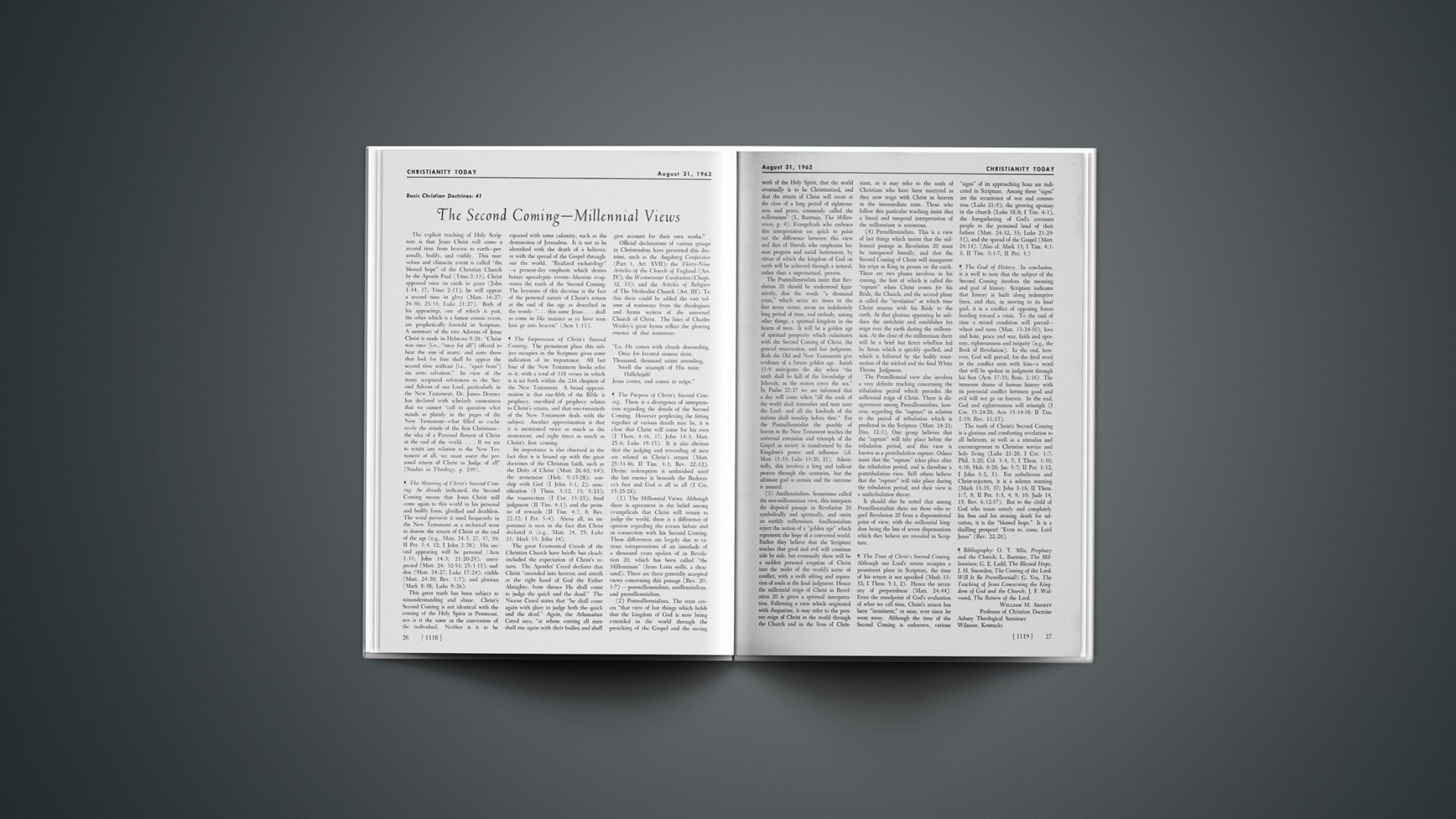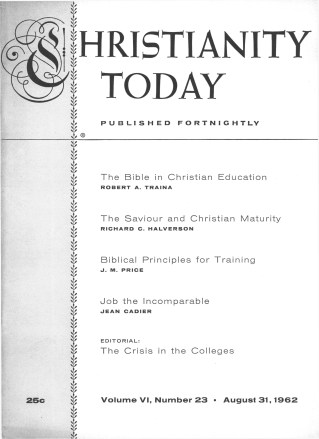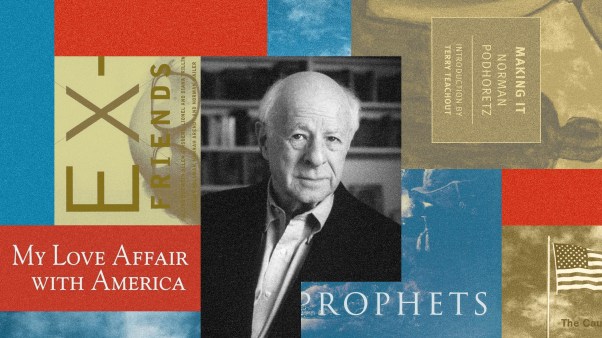The explicit teaching of Holy Scripture is that Jesus Christ will come a second time from heaven to earth—personally, bodily, and visibly. This marvelous and climactic event is called “the blessed hope” of the Christian Church by the Apostle Paul (Titus 2:13). Christ appeared once on earth in grace (John 1:14, 17; Titus 2:11); he will appear a second time in glory (Matt. 16:27; 24:30; 25:31; Luke 21:27). Both of his appearings, one of which is past, the other which is a future cosmic event, are prophetically foretold in Scripture. A summary of the two Advents of Jesus Christ is made in Hebrews 9:28: “Christ was once [i.e., “once for all”] offered to bear the sins of many; and unto them that look for him shall he appear the second time without [i.e., “apart from”] sin unto salvation.” In view of the many scriptural references to the Second Advent of our Lord, particularly in the New Testament, Dr. James Denney has declared with scholarly earnestness that we cannot “call in question what stands so plainly in the pages of the New Testament—what filled so exclusively the minds of the first Christians—the idea of a Personal Return of Christ at the end of the world.… If we are to retain any relation to the New Testament at all, we must assert the personal return of Christ as Judge of all” (Studies in Theology, p. 239).
The Meaning of Christ’s Second Coming. As already indicated, the Second Coming means that Jesus Christ will come again to this world in his personal and bodily form, glorified and deathless. The word parousia is used frequently in the New Testament as a technical term to denote the return of Christ at the end of the age (e.g., Matt. 24:3, 27, 37, 39; 2 Pet. 3:4, 12; 1 John 2:28). His second appearing will be personal (Acts 1:11; John 14:3; 21:20–23); unexpected (Matt. 24:32–51; 25:1–13); sudden (Matt. 24:27; Luke 17:24); visible (Matt. 24:30; Rev. 1:7); and glorious (Mark 8:38; Luke 9:26).
This great truth has been subject to misunderstanding and abuse. Christ’s Second Coming is not identical with the coming of the Holy Spirit at Pentecost, nor is it the same as the conversion of the individual. Neither is it to be equated with some calamity, such as the destruction of Jerusalem. It is not to be identified with the death of a believer, or with the spread of the Gospel throughout the world. “Realized eschatology”—a present-day emphasis which denies future apocalyptic events—likewise evaporates the truth of the Second Coming. The keystone of this doctrine is the fact of the personal nature of Christ’s return at the end of the age as described in the words: “… this same Jesus … shall so come in like manner as ye have seen him go into heaven” (Acts 1:11).
The Importance of Christ’s Second Coming. The prominent place this subject occupies in the Scripture gives some indication of its importance. All but four of the New Testament books refer to it, with a total of 318 verses in which it is set forth within the 216 chapters of the New Testament. A broad approximation is that one-fifth of the Bible is prophecy, one-third of prophecy relates to Christ’s return, and that one-twentieth of the New Testament deals with the subject. Another approximation is that it is mentioned twice as much as the atonement, and eight times as much as Christ’s first coming.
Its importance is also observed in the fact that it is bound up with the great doctrines of the Christian faith, such as the Deity of Christ (Matt. 26:63, 64); the atonement (Heb. 9:13–28); sonship with God (1 John 3:1, 2); sanctification (1 Thess. 3:12, 13; 5:23); the resurrection (1 Cor. 15:23); final judgment (2 Tim. 4:1); and the promise of rewards (2 Tim. 4:7, 8; Rev. 22:12; 1 Pet. 5:4). Above all, its importance is seen in the fact that Christ declared it (e.g., Matt. 24; 25; Luke 21; Mark 13; John 14).
The great Ecumenical Creeds of the Christian Church have briefly but clearly included the expectation of Christ’s return. The Apostles’ Creed declares that Christ “ascended into heaven; and sitteth at the right hand of God the Father Almighty; from thence He shall come to judge the quick and the dead.” The Nicene Creed states that “he shall come again with glory to judge both the quick and the dead.” Again, the Athanasian Creed says, “at whose coming all men shall rise again with their bodies, and shall give account for their own works.”
Official declarations of various groups in Christendom have presented this doctrine, such as the Augsburg Confession (Part 1, Art. XVII); the Thirty-Nine Articles of the Church of England (Art. IV); the Westminster Confession (Chaps. 32, 33); and the Articles of Religion of The Methodist Church (Art. III). To this there could be added the vast volume of testimony from the theologians and hymn writers of the universal Church of Christ. The lines of Charles Wesley’s great hymn reflect the glowing essence of that testimony:
“Lo, He comes with clouds descending,
Once for favored sinners slain;
Thousand, thousand saints attending,
Swell the triumph of His train; Hallelujah!
Jesus comes, and comes to reign.”
The Purpose of Christ’s Second Coming. There is a divergence of interpretation regarding the details of the Second Coming. However perplexing the fitting together of various details may be, it is clear that Christ will come for his own (1 Thess. 4:16, 17; John 14:3; Matt. 25:6; Luke 19:15). It is also obvious that the judging and rewarding of men are related to Christ’s return (Matt. 25:31–46; 2 Tim. 4:1; Rev. 22:12). Divine redemption is unfinished until the last enemy is beneath the Redeemer’s feet and God is all in all (1 Cor. 15:25–28).
(1) The Millennial Views. Although there is agreement in the belief among evangelicals that Christ will return to judge the world, there is a difference of opinion regarding the events before and in connection with his Second Coming. These differences are largely due to various interpretations of an interlude of a thousand years spoken of in Revelation 20, which has been called “the Millennium” (from Latin mille, a thousand). There are three generally accepted views concerning this passage (Rev. 20:1–7)—postmillennialism, amillennialism, and premillennialism.
(2) Postmillennialism. The term covers “that view of last things which holds that the kingdom of God is now being extended in the world through the preaching of the Gospel and the saving work of the Holy Spirit, that the world eventually is to be Christianized, and that the return of Christ will occur at the close of a long period of righteousness and peace, commonly called the millennium” (L. Boettner, The Millennium, p. 4). Evangelicals who embrace this interpretation are quick to point out the difference between this view and that of liberals who emphasize human progress and social betterment, by virtue of which the kingdom of God on earth will be achieved through a natural, rather than a supernatural, process.
The Postmillennialists insist that Revelation 20 should be understood figuratively, that the words “a thousand years,” which occur six times in the first seven verses, mean an indefinitely long period of time, and embody, among other things, a spiritual kingdom in the hearts of men. It will be a golden age of spiritual prosperity which culminates with the Second Coming of Christ, the general resurrection, and last judgment. Both the Old and New Testaments give evidence of a future golden age. Isaiah 11:9 anticipates the day when “the earth shall be full of the knowledge of Jehovah, as the waters cover the sea.” In Psalm 22:27 we are informed that a day will come when “all the ends of the world shall remember and turn unto the Lord: and all the kindreds of the nations shall worship before thee.” For the Postmillennialist the parable of leaven in the New Testament teaches the universal extension and triumph of the Gospel as society is transformed by the Kingdom’s power and influence (cf. Matt. 13:33; Luke 13:20, 21). Admittedly, this involves a long and tedious process through the centuries, but the ultimate goal is certain and the outcome is assured.
(3) Amillennialism. Sometimes called the non-millennarian view, this interprets the disputed passage in Revelation 20 symbolically and spiritually, and omits an earthly millennium. Amillennialists reject the notion of a “golden age” which represents the hope of a converted world. Rather they believe that the Scripture teaches that good and evil will continue side by side, but eventually there will be a sudden personal eruption of Christ into the midst of the world’s scene of conflict, with a swift sifting and separation of souls at the final judgment. Hence the millennial reign of Christ in Revelation 20 is given a spiritual interpretation. Following a view which originated with Augustine, it may refer to the present reign of Christ in the world through the Church and in the lives of Christians, or it may refer to the souls of Christians who have been martyred as they now reign with Christ in heaven in the intermediate state. Those who follow this particular teaching insist that a literal and temporal interpretation of the millennium is erroneous.
(4) Premillennialism. This is a view of last things which insists that the millennial passage in Revelation 20 must be interpreted literally, and that the Second Coming of Christ will inaugurate his reign as King in person on the earth. There are two phases involvea in his coming, the first of which is called the “rapture” when Christ comes for his Bride, the Church, and the second phase is called the “revelation” at which time Christ returns with his Bride to the earth. At that glorious appearing he subdues the antichrist and establishes his reign over the earth during the millennium. At the close of the millennium there will be a brief but fierce rebellion led by Satan which is quickly quelled, and which is followed by the bodily resurrection of the wicked and the final White Throne Judgment.
The Premillennial view also involves a very definite teaching concerning the tribulation period which precedes the millennial reign of Christ. There is disagreement among Premillennialists, however, regarding the “rapture” in relation to the period of tribulation which is predicted in the Scripture (Matt. 24:21; Dan. 12:1). One group believes that the “rapture” will take place before the tribulation period, and this view is known as a pretribulation rapture. Others insist that the “rapture” takes place after the tribulation period, and is therefore a posttribulation view. Still others believe that the “rapture” will take place during the tribulation period, and their view is a midtribulation theory.
It should also be noted that among Premillennialists there are those who regard Revelation 20 from a dispensational point of view, with the millennial kingdom being the last of seven dispensations which they believe are revealed in Scripture.
The Time of Christ’s Second Coming. Although our Lord’s return occupies a prominent place in Scripture, the time of his return is not specified (Mark 13:32; 1 Thess. 5:1, 2). Hence the necessity of preparedness (Matt. 24:44). From the standpoint of God’s evaluation of what we call time, Christ’s return has been “imminent,” or near, ever since he went away. Although the time of the Second Coming is unknown, various “signs” of its approaching hour are indicated in Scripture. Among these “signs” are the recurrence of war and commotion (Luke 21:9); the growing apostasy in the church (Luke 18:8; 1 Tim. 4:1), the foregathering of God’s covenant people to the promised land of their fathers (Matt. 24:32, 33; Luke 21:29–31), and the spread of the Gospel (Matt. 24:14). (Also cf. Mark 13; 1 Tim. 4:1–3; 2 Tim. 3:1–7; 2 Pet. 3.)
The Goal of History. In conclusion, it is well to note that the subject of the Second Coming involves the meaning and goal of history. Scripture indicates that history is built along redemptive lines, and that, in moving to its final goal, it is a conflict of opposing forces heading toward a crisis. To the end of time a mixed condition will prevail—wheat and tares (Matt. 13:24–30), love and hate, peace and war, faith and apostasy, righteousness and iniquity (e.g., the Book of Revelation). In the end, however, God will prevail, for the final word in the conflict rests with him—a word that will be spoken in judgment through his Son (Acts 17:31; Rom. 2:16). The immense drama of human history with its perennial conflict between good and evil will not go on forever. In the end, God and righteousness will triumph (1 Cor. 15:24–28; Acts 15:14–18; 2 Tim. 2:19; Rev. 11:15).
The truth of Christ’s Second Coming is a glorious and comforting revelation to all believers, as well as a stimulus and encouragement to Christian service and holy living (Luke 21:28; 1 Cor. 1:7; Phil. 3:20; Col. 3:4, 5; 1 Thess. 1:10; 4:18; Heb. 9:28; Jas. 5:7; 2 Pet. 3:12; 1 John 3:2, 3). For unbelievers and Christ-rejecters, it is a solemn warning (Mark 13:35, 37; John 3:18; 2 Thess. 1:7, 8; 2 Pet. 3:3, 4, 9, 10; Jude 14, 15; Rev. 6:12–17). But to the child of God who trusts utterly and completely his Son and his atoning death for salvation, it is the “blessed hope.” It is a thrilling prospect! “Even so, come, Lord Jesus” (Rev. 22:20).
Bibliography: O. T. Allis, Prophecy and the Church; L. Boettner, The Millennium; G. E. Ladd, The Blessed Hope; J. H. Snowden, The Coming of the Lord: Will It Be Premillennial?; G. Vos, The Teaching of Jesus Concerning the Kingdom of God and the Church; J. F. Walvoord, The Return of the Lord.
Professor of Christian Doctrine
Asbury Theological Seminary
Wilmore, Kentucky










